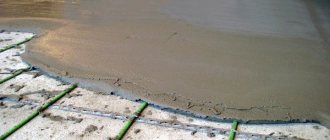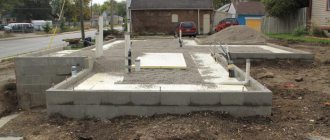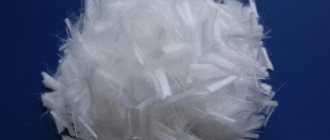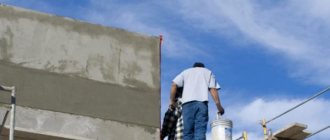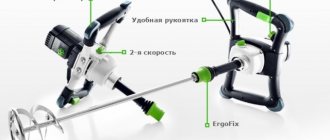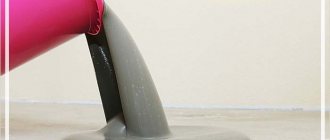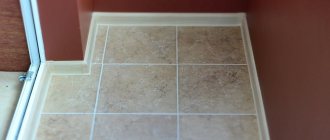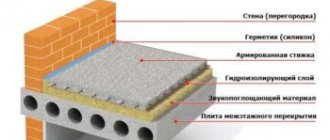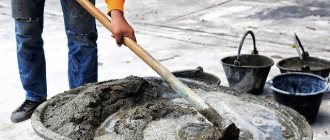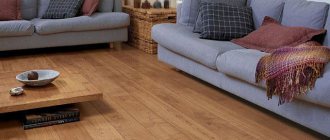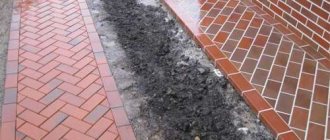Sika® MixPlast Plasticizing additive for ready-mixed sand concrete
To learn more
Sikament® CementPlast Plasticizing additive for sand concrete
To learn more
SikaPlast®-1 BetonPlast Plasticizer for concrete
To learn more
Sika® Antifreeze N9 Superplasticizing additive-hardening accelerator with antifreeze effect.
To learn more
Sika® Antifreeze FS-1 Hardening accelerator with antifreeze effect.
To learn more
Sika® Antifreeze Plast Complex additive for winter concreting
To learn more
SikaLatex® Additive for increasing the elasticity of mortars, creating thin screeds and adhesive layers.
To learn more
Sikament® BV 3M Plasticizing additive for concrete and mortars.
To learn more
Sika® 1 Plus Water-repellent additive for concrete and various cement mortars.
To learn more
Sika® Mix Plus Additive for plaster and masonry mortars, replacing lime.
To learn more
SikaFiber® Force-54 Macro synthetic fiber for concrete.
To learn more
SikaFiber® PPM-12 High quality fiber based on polypropylene.
To learn more
Sika®-4A Liquid hardening accelerator for cementitious compounds, designed for the primary sealing of active water leaks and fixation of various parts.
To learn more
SikaPlast®-520 N Superplasticizer for concrete and mortars
To learn more
SikaCem®-1 Color High quality pigments for concrete and mortars, UV resistant.
To learn more
Sikament®-1 Rapid Complex additive for concrete and mortars
To learn more
SikaPlast Concrete Superplasticizer for concrete and cement mortars
To learn more
SikaPlast Floor Superplasticizer for concrete floors
To learn more
Sika® Separol-600 Multi-purpose grease
To learn more
Showing 19 of 19
The Sika company (Switzerland), one of the world's leading manufacturers of construction chemicals, produces various additives for concrete: plasticizers, modifiers, waterproofing materials, hardening accelerators and other materials. These substances improve concrete mixtures in many respects - strength, workability, water resistance, frost resistance, chemical resistance and others. Chemical additives for Sika concrete allow the construction of reinforced concrete and monolithic buildings and structures at temperatures down to -25 °C, which is very important for our country.
Main types of additives for Sika® concrete
- Waterproofing additives for concrete – Sika® 1 Plus. This material is widely used in cementitious floor screeds and plaster mortars. Chemical water-repellent additives for concrete contain water-repellent agents that block capillaries in the cement stone and at the same time maintain its vapor permeability.
- Plasticizers for concrete – Sikament® BV 3M, Sika® Antifreeze N9, Sika® Latex. These materials are added to concrete and mortars, adhesive compositions and plasters, and cement-sand floor screeds. Chemical plasticizing additives for concrete improve the workability and plasticity of mixtures and increase the strength and water resistance of concrete. Plasticizer for mortar and concrete Sika® Antifreeze N9 is a complex additive that ensures rapid hardening of concrete.
- Hardening accelerators – Sika® Antifreeze N9, Sika® Antifreeze FS–1, Sika®–4A. These chemical additives for concrete ensure rapid hardening of concrete and mortar at temperatures down to -25 °C. A distinctive feature is the absence of chlorides and other substances that cause corrosion of steel reinforcement. The chemical additive Sika®–4A is used in grouting solutions designed to quickly seal active water leaks and fix various parts.
DIY screed for heated floors
DIY screed for heated floors
After you have decided on the choice of a heated floor and have installed a water heated floor or installed an electric heated floor with your own hands, you can proceed to pouring the screed for the heated floor
Screed
for a heated floor it is a heat distributor and its production is a very important stage, no less important than assembling the water or electric heated floor
with your own hands
. Many people do not attach importance to this, but in vain, since the appearance and durability of the heated floor covering, including the finish, will directly depend on the quality of the screed.
For example, if you buy a ready-made cement mixture from a low-quality manufacturer or do it incorrectly with your own hands, then after some time has passed after pouring the screed for a heated floor, it will begin to deform, crack and sag due to temperature effects, due to which the top decorative layer, for example , the tiles will also fail ahead of time. The screed for a heated floor must be resistant to deformation when exposed to temperature and not crack, and also have high thermal conductivity in order to maximize the transfer of heat produced by the heating elements of the heated floor.
We set up beacons for screeds under heated floors
In order for the screed for a heated floor to be rigidly connected to the base of the floor, it is recommended to make through holes in the heat-insulating material with a diameter of 2-3 cm per 1m2, 4-5 pieces; also in rooms with a large square footage, for a rigid connection and to prevent displacement of the screed for a heated floor, you can make a strip without thermal insulation 8-10 cm thick around the perimeter of the room. The level of the screed for a heated floor is calculated in such a way that it does not overlap the level of the door threshold, so we knock the level away from the doorway. We find the highest place on the floor - the zero point of our surface, from which we will push off, taking into account the concrete layer of our screed with our own hands
, and it should not be less than 3 cm. The beacons are installed parallel to each other to make it more convenient for us to pull the screed for the heated floor.
Beacons should not be placed far from the walls - maximum 10-30cm. If the distance of the beacons from the wall is increased, then there is a high probability that the angle between the wall and the floor will be uneven. The distance between the beacons on both sides should be 10 cm less than the rule. That is, if the length of your rule is 2 m, then the distance between the beacons is 1.7-1.8 m. The rule is a tool that is used to stretch and level the solution, guiding it along the beacons.
If you need to place more than two beacons, then a fishing line or thread is stretched between the outer beacons and the middle beacons are aligned to the level of this fishing line. As a solution for pouring screeds for heated floors, you can use special mixtures sold in stores, which have greater thermal conductivity and a certain plasticity compared to ordinary cement-sand mortar, since they add various kinds of additives and plasticizers that give miracle properties to concrete . But it will be more expensive than preparing a similar solution for pouring screed
for a warm floor, which we will make
with our own hands
.
Before the final pouring of the concrete solution, it is necessary to check the functionality of the heated floor system, depending on what type you prefer. You can read about how systems of different types of heated floors are checked on the pages: Do-it-yourself water heated floor Do-it-yourself electric heated floor Installation of the system Heat mat (thermomat) Do-it-yourself infrared heated floor
Preparing a solution for pouring screed for heated floors
We will need: Polypropylene fiber (5-20mm) 0.9 kg. per 1 m3 River sand + cement not lower than grade m-300, or better yet grade m-500 Prepare a solution for screeding a heated floor grade 100:
500 (brand of cement) - 1 bucket, 5 (buckets of sand) = 100 (brand of ready-made mortar). Cement of grade 500 is taken, the ratio of cement to sand is one to five, that is, one bucket of cement to five buckets of sand. The solution should not be liquid, since excessive water content in the solution contributes to the loss of strength of the screed and is one of the reasons for the appearance of shrinkage cracks. The solution should have the consistency of a thick dough, without lumps, not crumbly; on a flat surface it should not spread, but only slightly blur. To make the solution elastic, a plasticizer is added to the mixture; such a solution will spread well and fill all voids and will not contain air bubbles. It is necessary to strictly adhere to the norms for the consumption of plasticizer when mixing concrete mortar, since if it is not in the mortar in the regulated quantity or is absent altogether, the screed will begin to crack over time. It is recommended to add a cement additive, for example, Uponor, to prevent cracking of the screed (homogenization) and to increase its level of thermal conductivity. Consumption within 0.2 liters per 1 m2.
Folk method: Making a mortar of grade 100: Add a self-leveling quick-hardening floor to the screed. Approximately half a bucket of mortar for a self-leveling floor. And as a plasticizer it works great, and after 40-60 minutes you can walk on the floor and clean it.
Filling the screed with your own hands.
Let us remind you that the minimum height of the screed (especially for water heated floors) is 3 cm, the maximum is 7 cm, with the use of thermal insulation the minimum thickness is 5 cm. And do not forget about the thermal joints that are made even when installing an electric or water heated floor in that if the area of the future concrete slab is more than 40 m2 or one of the sides is more than 8 m.
We evenly cover the underfloor heating system with the solution; it is recommended to smooth the solution along the pipes or cables. We make sure that no air pockets remain, especially near the heating circuit, as this can lead to undesirable consequences (overheating and further failure of the underfloor heating system). Do-it-yourself concrete mortar for
it must be used within 1-1.5 hours, in no case should it be left (as many workers do) the next day, filled with water and covered with film, if you did not manage to use it in one day. Filling the screed occurs at one time, that is, you cannot fill one part of the room with the solution today and another the next day. The only exceptions are expansion joints (when on the first day the screed is poured from the beginning to the expansion joint, and on the next day it is poured from the expansion joint to which it was poured on the first day and to the next expansion joint or to the end of the room), pouring the screed in different rooms or screeds that have different levels (in this case, a damper seam 1-2 cm wide must be made between the layers of the screed).
When pouring a screed with a concrete solution that does not contain plasticizers and other additives, it is necessary to lightly (so as not to damage the heated floor system) pierce the liquid concrete solution with a thin rod to avoid air voids in the thickness of the screed, since when pouring the solution, air spheres are formed, which cannot come out on their own due to the viscosity and heaviness of the solution. This problem can be solved with a puncture.
Caring for heated floor screed
One of the main reasons for screed failure is improper care after pouring. The screed should be moderately moistened with water 2-3 times a day, a couple of days after the screed is poured, you need to remove the beacons from it, treat the places where they were with primer for mineral surfaces and rub them with fresh solution. After this, the screed is again moderately moistened with water and covered with plastic wrap for two weeks. If you are not satisfied with covering the screed with plastic film, then do not stop moistening the screed 2-3 times a day for 7-11 days. As a standard, the screed will gain its final strength after 25-28 days, after which you can proceed to the final coating of the screed for heated floors.
Buy a stamp for concrete At the final stage of the final decorative coating of the screed, you can use a more economical and less banal option than ceramic tiles, namely, apply a thin layer of cement mixture (0.6 - 10 mm) to the prepared surface of the screed and use stamps for concrete to emboss or printing a specific texture of your choice. You will save significantly on tiles and get a durable, reliable coating with good thermal conductivity and heat transfer. Read more about this on the page Thin-layer decorative concrete.
All pages in this section: Choosing a heated floor Do-it-yourself electric heated floor Do-it-yourself water heated floor Do-it-yourself infrared heated floor Thermomat system Screed for heated floors
Related articles: Heating system "warm baseboard" Installation of warm baseboards
Instructions for use
Regular C-3 powder is a viscous, coffee-colored liquid with a density of 1.15–1.2 g/m³. The product is sold in containers of different volumes - from 0.5 to 10 liters. The product, which you mix yourself, is compatible with the following building materials:
- Cement and Portland cement;
- Solid aggregates according to GOST 8267-93 – sandstone and crushed stone for construction work;
- Sand.
Preparing the mixture with your own hands is not difficult. To do this, you will need a deep container in which the two ingredients will be mixed. Professionals advise adding 0.5–0.8 liters of diluted product per 100 kg of cement. The resulting cement mixture can be used for pouring screeds, building walls and ceilings.
It is worth considering that you should not add a plasticizer for underfloor heating in larger quantities (1–2 liters per 100 kg of cement), since you will receive a solution with parameters that are more suitable for pouring monolithic blocks and installing reinforced concrete structures.
Method of dilution: the dry additive is diluted in water at the rate of 200 g per 1 liter of water. Powdered substances must not be transported in fabric or other bags. Powder is transported only in plastic bags. How to mix with your own hands and calculate the amount of cement powder? Professionals advise using the following formula to calculate dry additives: 0.5*100/35=1.45 kg. 0.5 kg is the mass of the dry additive, 100 kg is the mass of cement, 35% is the amount of plasticizer in the solution.
Use the manufacturers' instructions when mixing your own dry mortar. On the back of the package it is written in detail in what doses and with what substances the powder is combined. Dilute the dry additive in warm water to obtain a homogeneous mass and let it brew for 1-2 hours.
At what time and in what quantities should a plasticizer be used? Since the additive increases the setting time of concrete, experts strongly recommend using it to a minimum during the cold season.
Note that the general scheme for preparing the solution in winter is practically no different from the generally accepted technology - you will also need a small container in which you can dilute the dry mixture.
The more substance you add to the solution, the slower the concrete will set. Experts recommend adding 0.06 kg of the substance per 100 kg of sand. This consistency is ideal for pouring screed in rooms with negative temperatures or poor ventilation.
List of the best plasticizers:
- SP-1 S-3 is an analogue of foreign powder like “Mighty 100”, which is produced in Germany. The weight of the additive is 0.2–0.7% by weight of cement. Increases the fluidity of mortar mixtures by 6–9 times. Reduces the water requirement of cement by 15%, increases strength by 30% and corrosion resistance by 3–4 times;
- The “Warm Floor” plasticizer HLV-75 is intended for preparing a rough base for a warm water or electric floor with your own hands. Substance consumption: 0.5–2 l per 100 kg of cement. Reduces water consumption by 30%, increases the strength of concrete by 25%, accelerates hardening by 3 times;
- Batichem supplement is a broad-spectrum powder. Used when pouring screed under heated floors. The substance significantly improves pumping of concrete by 30–40%, reduces water absorption by 20% and reduces shrinkage of concrete during setting. In addition, a plasticizer for underfloor heating increases the final strength of concrete and stabilizes the process of cement hydration.
- Rehau plasticizer is a premium product. This powder is added to the concrete solution when constructing a screed under a heated floor. In addition to increasing the elasticity of the solution, first-class products have high environmentally friendly qualities: they are not flammable and do not harm human health. Elite powder increases the thermal conductivity and strength of the sub-base for heated floors.
The universal additive Rehau is easy to mix with your own hands (a person does not need to know the proportions). Even a gross violation of the consistency will not lead to a decrease in the performance of the solution.
Advantages of plasticizers
Additives that improve the quality of concrete are included in almost every solution due to a lot of advantages that are revealed both during use and in finished structures created with their help:
- The main thing for which a plasticizer is needed is to increase the plasticity of the solution. It completely fills the entire volume, closes pores and does not cause any difficulties in working;
- There is a saving in cement, the amount of which in solutions with plasticizers is reduced by 14-17% compared to concrete made without improving additives;
- The finished concrete base becomes a quarter stronger;
- Good plasticity and mobility allows the use of automatic concrete pumps for pouring. Work, especially in monolithic house construction, is completed much faster, but the strength remains the same;
- After laying, concrete with plasticizers does not require treatment with vibrators or other compaction methods. It also saves labor and time costs, resulting in lower construction costs;
- High adhesion and good fluidity make it possible to use concrete when pouring parts with reinforcement;
- Plasticizers increase the density of products, which simultaneously increases the moisture resistance of finished structures;
- Reducing the volume of liquid in the solution leads to increased frost resistance of concrete and increases its resistance to cracking;
- Plasticizers increase the adhesion of concrete to surfaces.
The disadvantages include an increase in the hardening time of the solution, so hardening accelerators are often added to the mixture at the same time.
Effect of additives on concrete
Plasticizers used in the installation of heated floors have a number of properties that have a positive effect on the concrete solution:
Scheme of a warm water floor.
- The high density of the solution is achieved by removing air bubbles from it. This significantly increases the efficiency of the heated floor, since the thermal insulation characteristics of the concrete mixture increase significantly during the hardening process.
- Plasticizers contribute to better solubility of the concrete mixture. They interact 100% with cement particles and do not cause any side effects.
- To improve the strength of concrete, it is not necessary to significantly increase the cement-water ratio. By reducing water consumption by only 15%, the strength of the screed increases by 30-50%.
- The high mobility and plasticity of the prepared solution makes the process of pouring the screed much easier. It is guaranteed to fill all the free space around the heating system tubes.
- The setting time of the concrete screed increases noticeably due to the action of the additive, which makes it possible to achieve maximum envelopment of the pipes with the solution.
- The plasticizer makes it possible to obtain high-strength self-compacting hydraulic concrete with the required level of heat resistance.
- The addition of a plasticizer does not cause the development of corrosion processes on communications and fittings poured with concrete.
- The use of additives contributes to the formation of a smooth surface of the screed, which facilitates the procedure for leveling it.
Pros and cons of sand concrete
Like any building material, sand concrete has both advantages and disadvantages. The first include:
- The absence of construction waste and dirt, which often suffers from a composition prepared with your own hands from ordinary sand and cement.
- Possibility to choose the brand of sand concrete, its fraction and other characteristics.
- Simplicity and ease of use. To prepare the mixture you do not need any special knowledge or tools.
- High characteristics of strength, frost resistance, ductility, water resistance.
- Possibility of use for both internal and external work, due to which sand concrete is often used outdoors.
Among the shortcomings it should be noted:
- Increased material consumption and higher price compared to conventional cement-sand mixtures.
- Large packaging. There is practically no material on sale packaged in small bags. As a result, it becomes unprofitable to use it if minor repairs are required.
- Cannot be used on vertical surfaces. For those who are wondering whether it is possible to plaster walls with sand concrete, we can give a clear answer - no.
Pros of the supplement
Plasticizers for the production of screed that have appeared on the construction market have made it possible to produce it in a shorter time and at the lowest cost.
Modern additives used for underfloor heating have the following advantages:
- no unpleasant odor;
- the quality of thermal insulation of the mixture increases, while the quality of the heating system improves;
- a mixture containing a plasticizer dissolves well even without the presence of water;
- fluid costs are reduced, but strength increases by 2 times;
- the pouring procedure is simplified, since the mixture becomes plastic and flows well around the heated floor communications;
- The screed with added additives dries quickly.
A solution containing a plasticizer for underfloor heating retains its characteristic properties for a long time.
Advantages of the supplement
Substances that are added to the concrete solution for laying screed on a heating floor have undeniable advantages:
- Increases the solubility of the concrete mixture. At the same time, the amount of added water decreases, which has a positive effect on the concrete hardening process.
- Increases the strength of the finished screed.
- Prevents corrosion processes on communication structures and fittings.
- They increase the density of the screed by displacing air bubbles from the solution, which, during hardening, makes it possible to increase the thermal insulation properties of the mixture and, accordingly, increase the efficiency of the heating system.
- Reduces the drying time of the solution.
- Increases the plasticity of the concrete mixture, which makes it more resistant to cracking, easier to lay and allows for better coverage of the laid heating system.
- Increases the total volume of coverage, which makes it possible to save consumables.
Screed with plasticizer is much easier to install
Why is a plasticizer needed?
Conventional concrete mixtures, prepared from standard components, in some cases do not have the required mobility, strength and other properties. To obtain the required characteristics of concrete, special additives are introduced into the solution. Each of them performs a specific function: it increases plasticity, accelerates the hardening process, and allows concrete to be poured at sub-zero temperatures. In the case of plasticizers, this is an increase in the mobility of the concrete mass, which will ensure the absence of voids.
The technology for installing heated floors involves simply pouring concrete onto tubes. The resulting screed must withstand very heavy loads, and possible voids inside it can lead to mechanical damage to the pipeline and failure of the heating system. To obtain the required strength, the thickness of the concrete layer above the pipes must be at least 2.5 - 3 cm.
By adding a plasticizer, the solution will be much thicker, denser, and its elasticity will increase.
In general, the properties of the plasticizer make it possible to use it to produce waterproof and high-strength concrete, to use it as an inhibitor that slows down corrosion processes due to excess chlorides, or to neutralize the addition of potassium nitrate, the weight of which can be 5% of the weight of the concrete solution. It should be noted that the introduction of plasticizers into concrete solutions does not worsen the porosity and vapor permeability of concrete. In addition, these additives are completely non-toxic and do not have an unpleasant odor, so they can be used for screeds in residential premises without any problems.
Sand concrete with polypropylene fiber and plasticizer
Fiber-reinforced sand concrete has only become in demand in the domestic market in the last few years. At the same time, construction dry mixtures with fiber have long gained enormous popularity among professional builders abroad. As always, we look at everything innovative with distrust and, out of habit, use old-fashioned compounds invented under Tsar Pea. We used construction concrete reinforced with steel particles only in the construction of especially critical structures (bank vaults, etc.)
Be that as it may, despite the ossified retrograde nature of the domestic construction market, dry mixtures for screeds with fiber fiber are still slowly beginning to interest Russian builders and finishers. Manufacturers of foam blocks were among the first to use fiber in Russia. In response to numerous “requests from workers of all countries,” in 2012 we launched the production of dry construction mixtures with fiber at our plant.
Our company offers reinforced and plasticized (with superplasticizer C-3) finishing dry mixtures and sand concrete: M300 and M350 of our own production, intended for the installation of high-quality floor screeds, with increased requirements for crack resistance and ductility. Dry mixtures with polypropylene fiber have a huge advantage over simple cement-sand compositions - they are initially reinforced! That is. When installing floor screeds made from fiber-reinforced mixtures, welded steel mesh is not required. In this case, you don’t have to think about the possible cracking of the screed when it “hardens” or is used.
“Hairs” of fiber, thoroughly mixed in the composition of sand concrete, form a reliable plastic skeleton of the future structure. A spatial structure is created where every square centimeter of screed securely holds on to its neighbors. They seem to be intertwined with thin but very strong fibers of polypropylene fiber.
In addition to fiber, our special dry mixtures contain superplasticizer-c3. The use of plasticizing additives can significantly improve the technical and operational characteristics of dry mixtures, concrete and mortars. The main advantages of using dry mixtures with a superplasticizer are:
- Increase in brand strength (with the same proportions of cement-water and sand) up to 25%
- Reduced water consumption when mixing the mixture (while maintaining the required plasticity)
- Less shrinkage during hardening of concrete, mortar or sand concrete (the screed does not “dry out”)
- High crack resistance (again due to the reduced shrinkage coefficient during hardening of the solution)
- Possibility of producing high-strength sand concrete m350 (due to adjustment of the water-cement ratio)
- Increased frost resistance of cast structures (which is especially important for outdoor areas, blind areas, paths, etc.)
More information about the benefits of using superplasticizers can be found in the article Concrete Additives.
DIY plasticizer
Necessary materials:
- Liquid soap;
- Diluted washing powder;
- Shampoo.
The plasticizer for underfloor heating screed is made from the following materials:
- Add 200 ml of liquid soap to 1 bag of cement. This solution is recommended for use in combination with expanded clay. The additive will increase the hardening time of the solution by 3–4 hours. Liquid soap is added directly while mixing the sand-cement mixture;
- The properties of slaked lime can also be used to reduce the rate of hardening of concrete. For 10 kg of cement, 60–70 g of slaked lime is added. Note that the more slaked lime you add, the slower the solution will harden. This feature is actively used by professional masons to finish difficult areas.
kaminyn.ru
